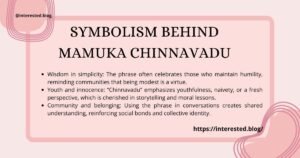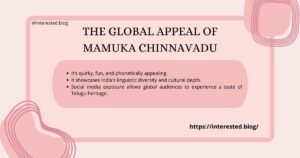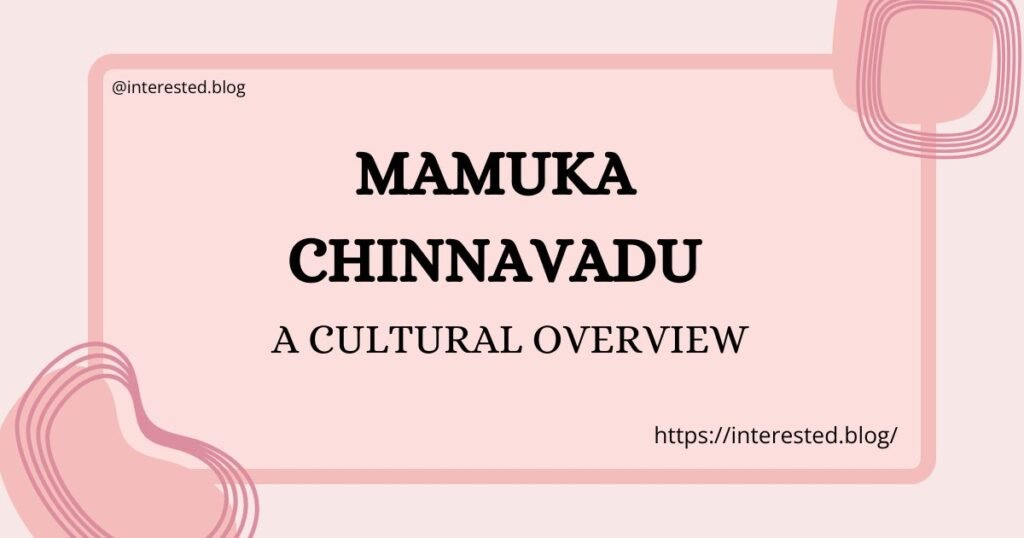Introduction
If you’ve recently stumbled upon the phrase Mamuka Chinnavadu, chances are you paused and thought—what does that even mean? You’re not alone. This intriguing expression has been circling around online platforms, social media conversations, and even casual group chats.
- For some, it’s a nostalgic reminder of regional culture, evoking childhood memories of stories and family gatherings.
- For others, it’s simply a funny, catchy phrase that sparks curiosity and makes them want to explore its origins further.
- The phrase has a unique charm because it sounds playful and affectionate, yet carries deeper layers of meaning rooted in tradition.
The sudden rise of Mamuka Chinnavadu in digital spaces shows how certain words—rooted in local traditions—can capture global attention, bridging cultures and generations in unexpected ways.
What is Mamuka Chinnavadu?
At its simplest, Mamuka Chinnavadu can be understood as a regional expression in Telugu that carries layers of meaning depending on context.
- “Mamuka” roughly translates to a title, nickname, or affectionate term with cultural undertones.
- “Chinnavadu” literally means the younger one or the little fellow, implying both youthfulness and endearment.
So, on the surface, Mamuka Chinnavadu might sound like a playful label for someone humble, young, or endearing. Yet, depending on tone and context, it can also carry witty, humorous, or even philosophical interpretations that are understood intuitively by locals.
Common uses include:
- Describing someone innocent, naive, or inexperienced.
- Referring to a younger member in a community or family hierarchy.
- Used humorously in banter among friends, creating bonds and playful teasing that strengthens relationships.
This flexibility in meaning is exactly what gives the phrase its charm and allows it to survive in both traditional and modern contexts.
Historical Background of Mamuka Chinnavadu
Every phrase has a story, and Mamuka Chinnavadu is no exception. Its history is deeply rooted in Telugu-speaking communities and their oral traditions, reflecting values, humor, and social dynamics over centuries.
- Early roots: Local villages likely coined the term as a casual nickname, often passed down through families and informal community interactions.
- Storytelling traditions: Grandparents and elders used it in folk tales, anecdotes, and playful teasing to teach lessons or entertain, embedding it in cultural memory.
- Community identity: Over time, the phrase became more than just words—it represented closeness, shared experiences, and a sense of belonging among neighbors and relatives.
Remarkably, such a small phrase survived modernization, traveling from village squares to digital platforms, demonstrating the resilience of local culture and the enduring appeal of regional expressions.
Linguistic Analysis of Mamuka Chinnavadu
Breaking down the phrase provides a fascinating glimpse into language, dialect, and regional nuance:
- Mamuka (మాముక): While not standardized in formal Telugu dictionaries, this part of the phrase hints at affectionate, informal usage with subtle cultural undertones.
- Chinnavadu (చిన్నవాడు): Literally translates as the younger one or little fellow, implying humility, youth, and sometimes innocence.
Possible translations could include:
- “The little one called Mamuka.”
- “Mamuka, the young fellow with charm and wit.”
- Or symbolically: “A humble soul carrying innocence and playfulness in society.”
Regional variations also add nuance. In certain villages, pronunciation and intonation might alter the meaning slightly, making it affectionate in one area and humorously teasing in another. This dynamic ensures Mamuka Chinnavadu remains culturally rich and linguistically versatile.
Cultural Relevance of Mamuka Chinnavadu
Why does Mamuka Chinnavadu hold cultural significance? Language reflects values, and this phrase is a perfect example of how a few words can carry profound meaning.
- In folklore, Mamuka Chinnavadu often represents humility, innocence, or cleverness masked in simplicity.
- During festivals and gatherings, it may be used humorously to describe a younger participant or someone with a playful nature.
- In day-to-day interactions, it creates a subtle bond, reinforcing communal ties and shared cultural understanding.
Think of it as a cultural mirror: simple on the surface, yet reflecting the complex values, traditions, and humor of Telugu-speaking communities. Its continued use is a testament to how language evolves while preserving identity.
Mamuka Chinnavadu in Literature and Media
The phrase hasn’t gone unnoticed in literature and media, which often help preserve and popularize cultural expressions.
- Folk songs and poems: Traditional compositions sometimes weave the phrase in, highlighting innocence or character traits in memorable ways.
- Drama and storytelling: Village performances use Mamuka Chinnavadu to bring characters to life, often adding humor, relatability, and moral lessons.
- Modern media: Digital memes, short films, and online videos now incorporate it, bridging traditional usage with contemporary audiences.
This evolution—from oral tradition to literature to digital media—demonstrates the adaptability and resilience of cultural language in an increasingly connected world.
Regional Interpretations of Mamuka Chinnavadu
The meaning of Mamuka Chinnavadu shifts subtly across regions, reflecting local dialects, cultural norms, and social hierarchies:
- Urban areas: Often used humorously among friends or in casual conversation, sometimes detached from its original cultural nuance.
- Rural areas: Carries traditional significance, symbolizing respect for simplicity, humility, and youth.
- Dialectal variations: Pronunciation differences and colloquial tweaks add unique flavors in each region, making the phrase dynamic and locally distinctive.
These regional interpretations help the phrase thrive, offering multiple layers of meaning that appeal to both local and broader audiences.
Religious and Spiritual Dimensions of Mamuka Chinnavadu
Interestingly, Mamuka Chinnavadu also enters spiritual and religious discourse, though subtly:
- Some connect it to humility before deities, where “the little one” represents surrender and modesty.
- In rural rituals, elders may use it symbolically to remind participants of innocence and virtue.
- Spiritual leaders occasionally reference it in teachings, emphasizing simplicity, patience, and moral grounding in everyday life.
This spiritual dimension enhances the phrase, showing that its influence extends beyond casual speech into areas of reflection and cultural philosophy.
Everyday Usage of Mamuka Chinnavadu
In daily life, Mamuka Chinnavadu pops up frequently, showing its adaptability:
- As a teasing nickname among siblings, friends, or community members.
- In lighthearted jokes during gatherings, often to describe someone inexperienced or playful.
- As a friendly marker for someone younger in a group, creating bonds through affectionate humor.
Humor is a central element, much like calling someone “chief” or “boss” in English jokingly. This playful usage ensures the phrase remains relatable, relevant, and socially engaging.
Symbolism Behind Mamuka Chinnavadu

Beneath its playful surface, Mamuka Chinnavadu carries deep symbolic meaning. It’s not just a label—it’s a representation of cultural values.
- Wisdom in simplicity: The phrase often celebrates those who maintain humility, reminding communities that being modest is a virtue.
- Youth and innocence: “Chinnavadu” emphasizes youthfulness, naivety, or a fresh perspective, which is cherished in storytelling and moral lessons.
- Community and belonging: Using the phrase in conversations creates shared understanding, reinforcing social bonds and collective identity.
Like many traditional expressions, it’s a small linguistic vessel carrying lessons about humility, respect, and playfulness across generations.
Mamuka Chinnavadu in Modern Pop Culture
In today’s digital age, the phrase has seamlessly transitioned into pop culture, appealing to both traditional and younger audiences.
- Films & TV: Screenwriters often include it in dialogues to infuse humor or highlight a character’s innocence.
- Memes and social media: Short videos, reels, and viral posts have repurposed the phrase for comedic effect, showing its adaptability.
- Younger generations: Millennials and Gen Z use it as slang, hashtags, or captions, blending nostalgia with modern humor.
This crossover demonstrates how Mamuka Chinnavadu bridges the gap between cultural heritage and contemporary trends, keeping it alive in the public consciousness.
Comparisons with Similar Local Phrases
Many languages develop expressions similar to Mamuka Chinnavadu, reflecting universal human tendencies to affectionately label younger or playful individuals.
- Telugu equivalents: “Pilla Dorakadu” or “Bava Chinnodu” carry similar nuances of humor, respect, and affection.
- Tamil parallels: “Chinna Paiyan” conveys a similar playful or youthful connotation.
- Hindi expressions: Words like “Chhotu” or “Munna” capture innocence and youthful charm.
- Global analogues: English nicknames such as “Little man,” “Kiddo,” or “Junior” reflect the same sentiment.
These comparisons highlight how linguistic creativity transcends cultural boundaries, showing that affectionate nicknames are a shared human trait.
Social Media and the Spread of Mamuka Chinnavadu
The digital revolution has amplified the visibility of Mamuka Chinnavadu, allowing it to reach global audiences.
- Memes: Users combine imagery with the phrase to evoke humor or relatability.
- Reels and short videos: Platforms like Instagram and TikTok showcase the phrase in playful skits.
- Hashtags: Viral trends have popularized it, sometimes detached from original cultural meanings.
Examples of online trends include funny skits portraying the “little fellow” trope, humorous exaggerations of innocence, and playful teasing between friends. Social media has essentially turned a regional phrase into a global conversation starter.
Influence of Mamuka Chinnavadu on Identity and Belonging
Language is a powerful marker of identity, and Mamuka Chinnavadu reinforces both cultural and personal belonging.
- Affirming regional pride: Speaking or referencing the phrase shows pride in Telugu heritage.
- Connecting generations: Older and younger speakers share humor and cultural memory through its use.
- Diaspora significance: For Telugu communities abroad, it serves as a comforting reminder of home and heritage.
In essence, using this phrase is more than casual speech—it’s a way of expressing connection, identity, and cultural continuity.
Criticism and Misinterpretations of Mamuka Chinnavadu
As with many culturally rooted phrases, Mamuka Chinnavadu is sometimes misunderstood or misused:
- Outsiders may misinterpret it as derogatory or trivial.
- Online, memes may distort its meaning for shock value or humor, losing the traditional nuance.
- Overuse or casual appropriation can strip it of cultural depth and significance.
These misinterpretations remind us that context matters: appreciating Mamuka Chinnavadu requires awareness of cultural background and sensitivity to tone.
Mamuka Chinnavadu in Contemporary Conversations
Today, Mamuka Chinnavadu frequently appears in modern dialogue:
- Podcasts: Creators reference it in discussions about language, humor, and culture.
- Interviews: Celebrities sometimes use it jokingly, reinforcing relatability.
- Public speeches and panels: Educators or cultural commentators highlight it as an example of regional linguistic richness.
Its continued presence in contemporary conversations demonstrates its enduring appeal and relevance, showing that cultural phrases can thrive alongside digital communication.
Academic Perspectives on Mamuka Chinnavadu
Academics offer unique insights into why the phrase continues to thrive:
- Linguists: Study its phonetic patterns, dialectal variations, and semantic evolution.
- Anthropologists: Examine its role in community bonding, oral storytelling, and social dynamics.
- Sociologists: Consider it a marker of regional identity, showing how language reinforces cultural belonging.
Such scholarly attention underscores that Mamuka Chinnavadu is more than casual speech—it’s a living artifact of Telugu linguistic and cultural heritage.
Lessons We Can Learn from Mamuka Chinnavadu
This phrase offers meaningful lessons applicable beyond language:
- Humility matters: Remaining modest and grounded is celebrated in the phrase’s essence.
- Simplicity is powerful: Simple expressions can convey wisdom, humor, and affection.
- Cultural preservation: Protecting and understanding local phrases helps maintain identity in a globalized world.
- Interpersonal bonds: Playful teasing and humor, as reflected in the phrase, strengthen relationships.
In a fast-paced society, Mamuka Chinnavadu reminds us to value connection, tradition, and the joy of shared language.
The Global Appeal of Mamuka Chinnavadu

Even non-Telugu speakers are drawn to Mamuka Chinnavadu:
- It’s quirky, fun, and phonetically appealing.
- It showcases India’s linguistic diversity and cultural depth.
- Social media exposure allows global audiences to experience a taste of Telugu heritage.
This cross-cultural fascination illustrates how language, even when rooted locally, can transcend borders and spark curiosity worldwide.
Future of Mamuka Chinnavadu in Digital Culture
Looking ahead, the phrase is poised for continued relevance:
- Memes and short videos will keep it circulating in humorous ways.
- Lexicographical recognition: With growing popularity, it may appear in dictionaries or online glossaries.
- Cultural documentation: Scholars may continue to record its history, meanings, and social functions.
The phrase’s journey—from village nickname to global digital presence—demonstrates how traditional expressions can adapt, survive, and thrive.
Final Thoughts
The story of Mamuka Chinnavadu is a reminder that language is both playful and profound:
- It connects generations, from grandparents telling tales to young creators making memes.
- It bridges traditional and modern culture, blending heritage with contemporary humor.
- It reflects values like humility, innocence, and community, all embedded in just a few words.
Preserving and celebrating phrases like Mamuka Chinnavadu ensures that cultural treasures remain alive, offering insight, joy, and identity in a globalized world.
FAQs About Mamuka Chinnavadu
Q. What does Mamuka Chinnavadu literally mean?
It translates to “the younger one called Mamuka” or “little fellow,” often implying humility or affection.
Q. Is Mamuka Chinnavadu used only in Telugu-speaking regions?
Primarily yes, though digital media has introduced it to non-Telugu speakers who enjoy its humor and sound.
Q. Why has Mamuka Chinnavadu become popular online?
Its humorous, catchy nature makes it perfect for memes, social media reels, and viral content.
Q. Does the phrase have spiritual significance?
In certain contexts, it symbolizes humility, innocence, and moral grounding in religious or cultural practices.
Q. Can Mamuka Chinnavadu evolve further in the future?
Absolutely. With social media and cross-cultural interactions, it may gain new meanings, spellings, or even mainstream recognition.
Read More Content: lac132zaw


